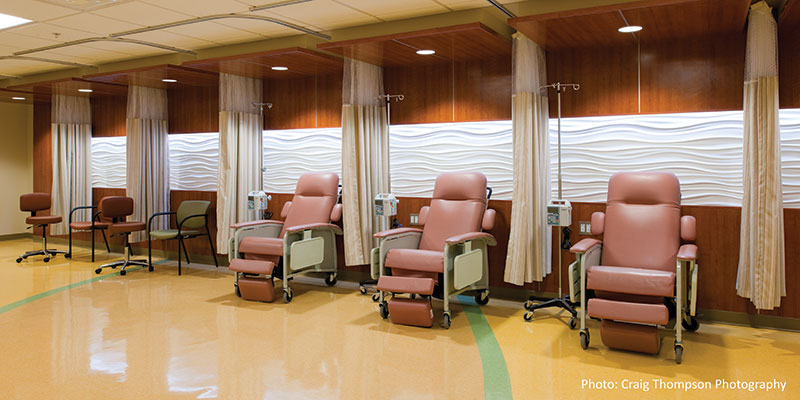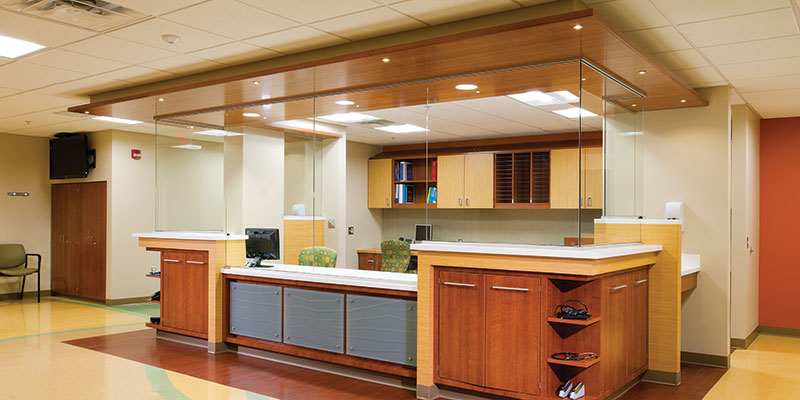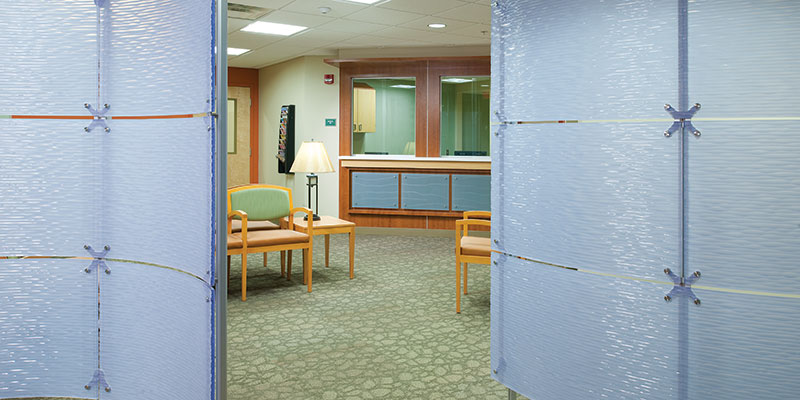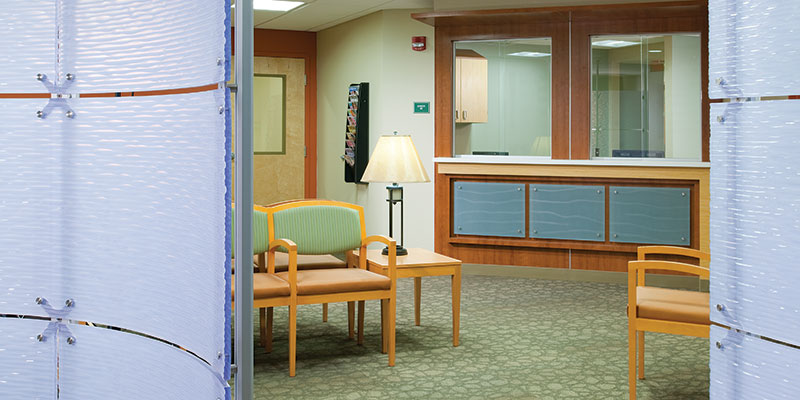JMA Medical Office Building
Designed for Quality Care
Healthcare design requires a special blend of aesthetics, performance and empathy. The architects and designers at IKM Incorporated located in Pittsburgh, PA use these concepts to develop customized healthcare spaces, which make up 85 percent of their work. “As architects we feel we have the ability to improve healing and affect the quality of treatment,” says Matt Hansen, Architect and Project Manager for IKM. “We believe that if given the opportunity we can be an asset to nurses and physicians and help them to do their job in a more efficient way.” IKM bleds traditional, transitional and contemporary materials and colors to create specialized spaces.
Comfort
The process of creating functional healthcare spaces begins with understanding the specific needs of the client. When the Jefferson Hospital West Penn Allegheny Oncology Network required more space, the practice moved into a newly built medical office complex. IKM won the project and was assigned the task of creating a new home for WPAON Jefferson. The challenge was to blend the technical requirements of the medical center with the building owner’s model, all without losing site of patient and staff comfort.
Hansen, along with IKM’s Interior Design Manager Mary Salamon-Moro, IIDA, met extensively with the ultimate end-users of the space, the WPAON staff, to learn how to best serve patients and practitioners. These stakeholders informed the spatial layout for maximum efficiency and were pivotal in the finish selection process. “Our goal was to make as comfortable an environment as possible throughout, from the waiting room back through the infusion room. We wanted all those experiences to be soft and welcoming and warm,” says Hansen.
Any visit to a medical center can cause anxiety but for patients undergoing chemotherapy, there are also physical concerns. For one, the treatment makes patients feel cold. IKM specified Wilsonart Laminates in Amber Cherry with Tan Echo accents throughout the project to add familiarity and warmth. “Wood is something people are comfortable with. They have it at home,” says Hansen. “At the same time wood does not work in a medical environment. We don’t want porous materials that support bacterial growth. The challenge is to find a material that meets the requirements for comfort, but also performs in a technical way in terms of cleanability and durability.”
Wilsonart Laminate complements other high-performance engineered materials in the project to create solutions specific to the client’s needs. An important consideration for the WPAON practice is that patients are often self-conscious about their physical appearance. The building was originally designed using a medical model that includes public waiting areas and open circulation throughout the corridors. Since interior walls were out of the question, IKM created a 3Form partition to provide patients with privacy. Inside the partition, a custom-built reception desk transitions from resin panels to Wilsonart Laminate. “There is a sense of hospitality to the design,” says Salamon- Moro. “Within the clinic space, we intentionally used familiar finishes alongside the modern looking materials to make the space feel less institutional and more comfortable.”
Care
Patient comfort is only one component of a functional clinic. Creating a space that is pleasant for the staff is also important. “Quality of care is impacted by how care providers are feeling,” says Hansen. Each medical space designed by IKM reflects the needs and personalities of the people who work there. When staff is included in the finish selection process, not only do they feel more at home in the environment, but patients feel the space is more personal, and the treatments more humane.
WPAON clinic’s infusion room and nurses’ station are located in the back of the 5000 square-foot semi-subterranean suite. Nine treatment chairs are set up around a centralized nurses’ station, which carries over the Wilsonart Laminate and resin panel aesthetic from the waiting area. Three sides of the station are enclosed with glass, providing nurses a clear view of the chairs. Unlike the waiting area where separation is important, the infusion room is set up for easy access and close proximity. “We received patient feedback that there is a social component to treatment. Most appointments are regularly scheduled, and people form relationships while going through chemotherapy together,” says Hansen. In addition to the sense of community, the floor plan of the room reduces the steps the nurses have to take. “Anything we can do to reduce provider fatigue results in better care,” says Hansen.
Natural light is a component that IKM includes in their spaces whenever possible, but there are no windows in the back portion of the suite where the infusion room is located. “We started looking at different ways to achieve ambient lighting that could almost simulate the warmth of daylight,” says Hansen. IKM used routed Medium Density Fiberboard (MDF) panels framed by Wilsonart Laminate to create light features. “It is subtle, not decorative like a mural,” says Salamon-Moro. “It is more sculptural, more architectural.” Bulkheads finished in Wilsonart Laminate and edged with aluminum reveals house overhead lighting fixtures, and LED lights tucked behind the Wilsonart Laminate wall panels shine up at the contoured MDF. “Lighting is key in showcasing the beauty of the materials,” says Hansen.
Confidence
IKM’s interior design department is charged with the task of seeking out materials that look good and can perform in demanding healthcare environments. “All hospitals have facilities and maintenance departments that use aggressive cleaners,” explains Hansen. “When we introduce a new material into an environment, we need to know it is going to hold up to these harsh cleaners and still look and perform the way it did when we first put it in. We’ve put in a lot of research over time, and Wilsonart Laminate is a material we know stands up to all those cleaning and facilities maintenance requirements.”
Healthcare design, when done well, results in a functional, comfortable space that expresses compassion and confidence. Only when finishes wear or layout is cumbersome do people tend to notice. IKM makes sure that doesn’t happen. “We specify Wilsonart Laminate with the premium AEON™ finish which adds to the product’s durability and scratch resistance. It also makes the woodgrain more vibrant, almost photovoltaic,” says Salamon-Moro.
From a design standpoint, IKM works to reduce anxiety and make people more comfortable. And they do so with both patients and practitioners in mind. Specifying high-performance materials with traditional, transitional and contemporary aesthetics makes healthcare spaces that go beyond sterile institutions. “The healthcare facility market is really about making a difference in people’s lives,” says Hansen. “That is why healthcare design, to us, is so exciting.”
Click here for a PDF of this case study.








Sign In
Register